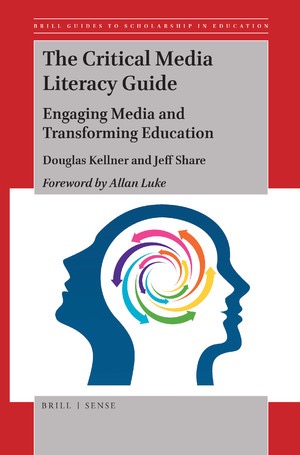critical media literacy
Select an item by clicking its checkbox
Reviewed by: Eric Fehr, Northwest Seminary - College
Date Reviewed: June 21, 2021
Date Reviewed: June 21, 2021
Over half the world’s population is now online, interconnected through a globally-networked media and consumer society. The convergence of information, media, and technology has created the predominant ecosystem of our time. Yet, most educational institutions are still teaching what and how they have for centuries, and are thus increasingly out-of-date and out-of-touch with our current needs. The Critical Media Literacy Guide: Engaging Media and Transforming Education provides a theoretical ...
Over half the world’s population is now online, interconnected through a globally-networked media and consumer society. The convergence of information, media, and technology has created the predominant ecosystem of our time. Yet, most educational institutions are still teaching what and how they have for centuries, and are thus increasingly out-of-date and out-of-touch with our current needs. The Critical Media Literacy Guide: Engaging Media and Transforming Education provides a theoretical framework and practical applications for educators and teacher education programs to transform education by putting critical media literacy into action in classrooms with students from kindergarten to university. Douglas Kellner and Jeff Share lay out the evolution of thinking and development of media and cultural studies, from the Frankfurt School to current intersectional theories about information and power that highlight the importance of race, gender, class, and sexuality. They provide insightful and accessible entry into theorizing education and information communication technologies through linking the politics of representation with critical pedagogy.
The increase in fake news, alternative facts, bots, and trolls, challenge our abilities to judge credibility and recognize bias. Kellner and Share present a critical lens and strategies to contextualize and analyze the dominant ideologies going viral across social media platforms and disseminated globally from enormous transnational corporations. The Critical Media Literacy Guide is a powerful resource to analyze and challenge representations and narratives of multiple forms of identity, privilege, and oppression. Since the struggle for social justice and democracy require new theories and pedagogies to maneuverer the constantly changing terrain, this book is essential for all educators. (From the Publisher)
The increase in fake news, alternative facts, bots, and trolls, challenge our abilities to judge credibility and recognize bias. Kellner and Share present a critical lens and strategies to contextualize and analyze the dominant ideologies going viral across social media platforms and disseminated globally from enormous transnational corporations. The Critical Media Literacy Guide is a powerful resource to analyze and challenge representations and narratives of multiple forms of identity, privilege, and oppression. Since the struggle for social justice and democracy require new theories and pedagogies to maneuverer the constantly changing terrain, this book is essential for all educators. (From the Publisher)
